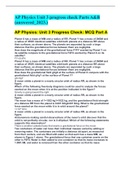Exam (elaborations)
AP Physics Unit 3 progress check Parts A&B (answered_2023.)
- Course
- Institution
- Book
AP Physics Unit 3 progress check Parts A&B (answered_2023.) AP Physics: Unit 3 Progress Check: MCQ Part A Planet X has a mass of MM and a radius of RR. Planet Y has a mass of 3M3M and a radius of 3R3R. Identical satellites orbit both planets at a distance RR above their surfaces, as shown abo...
[Show more]



